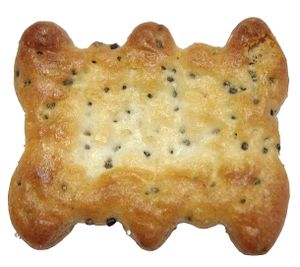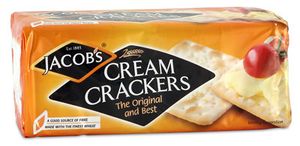Cracker
“At least you didn't call me Frenchy!”
“"He who says they can eat 10 crackers in one sitting without a glass of water, is lying.”
Crackers are subterranean nihilopod crustaceans (no-legged animals) of the infra order Leptotraganus which typically have thin and cartilaginous bodies (Greek: λεπτός/leptos = thin,τραγανός/traganos = cartilaginous). They inhabit most areas, and are generally covered with a thin exoskeleton an have small respiratory holes. Many animals, such as: Tortilla, Pretzel, Water Biscuit are not true crackers.
Evolution[edit | edit source]
Crackers are generally covered with thin exoskeletons, composed of many chemicals found in flour and water, and have small respiratory holes at regular intervals upon their backs. Crackers are found all around the world, except in places of extreme climates, especially in urban areas. Crackers vary in size, all though they are all around 3 inches in diameter.
There are about 100 species of cracker world wide, with more diverse ecosystems centering around urban areas. No cracker fossils have yet been found, since they have only been known to man for about 200 years. The earliest mention of crackers was in 1792, when large amounts of crackers had crawled onto ships, multiplied and had been transported around the world on large voyages.
Sexual Dimorphism[edit | edit source]
There are a few key differences in male and female crackers. Males often have thicker exoskeletons, embedded with scent emitting glands used in mating. Apart from that, there is no known way of telling a male cracker from a female.
Reproduction and Life Cycle[edit | edit source]
Male crackers attract a mate by emitting a scent from scent glands embedded within the exoskeletons. Crackers reproduce in external reproduction, similar to the Cnidarians, Corals. In the ground, tiny Cracker eggs form. The egg has a hard, brittle outside, to protect the developing embryo within. After about a day, the larva emerges, and instantly begins to eat as much as it can. This is because after the time of a few weeks (usually about two, but the bigger the cracker the longer the larval stage.) the exoskeleton forms, and from then on no more external growth can take place. This is known as a floxinal stage. After the floxinal stage has passed, the larva (around 1 inch across) will eat itself a small cave in which it will remain dormant. The larvae go into dormant stages so that there is time for the exoskeleton to fully form, to protect the cracker's fragile innards, and also because the adult cracker only has a lifespan of about 2 weeks, so it is important that the larva emerges at the right time. The time spent dormant largely varies on the cracker: Ritz's Cracker is dormant for only a few days, whereas Carr's cracker can be dormant for several decades.
Upon awaking the larvae will instantly dig upwards, to wards the surface. This is the brief mating season which lasts for a few days in mid August. The newly hatched crackers find mates, and they reproduce, repeating the cracker's life cycle. If the mating crackers do not return underground they will die. After the mating period, the crackers enter the adult stage, which mainly involves guiding more larvae to good hibernation places. The average cracker has an adult lifespan of three weeks.
Behavior[edit | edit source]
Crackers are very slow, due to their lack of limbs, although this has not affected their development or survival. Crackers are very inactive animals, although they are known to be able to communicate with larval crackers telling them where good food sources are, or where to hibernate. They do this in a way similar to the dancing of bees, but on a slower, smaller scale.
Crackers do not fight over mates, although it is often a 'race', to see which male will reach the mate first. Also, male crackers rarely confront each other - a smaller cracker will often just move away from a larger one, however, if a cracker were to accidentally tunnel into another's burrow, the cracker whose burrow has been invaded would attempt to fend off the intruder, although often it would just return of its own accord.
Crabs are omnivores. They feed on anything in the soil that they filter through their respiratory holes. This means that they get a very varied diet, including lots of minerals, which is essential to maintain a healthy exoskeleton.
Human Consumption[edit | edit source]
Crackers are widely consumed by humans, and crackers make up over 75% of all subterranean crustaceans that are caught, farmed and consumed worldwide. They are typically baked and served with various toppings. Shops sell various different species of cracker.
Little is known about these seclusive animals, and it would be awful if they were made extinct due to over consumption by the consumer, however major wildlife conservation organizations have done little to protect the Cracker.



